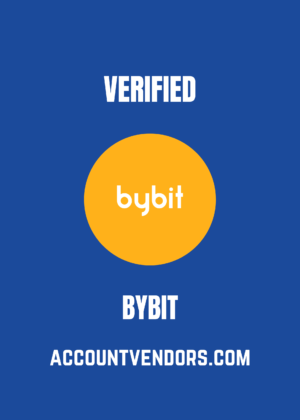Buy Verified AWS Accounts

Amazon Web Services (AWS), is an infrastructure service provided by Amazon.com that serves as a cloud computing platform and infrastructure service provider. AWS provides access to various cloud computing services including computing power, storage space, databases, machine learning analytics content delivery. AWS is one of the world’s most commonly-used and largest cloud platforms.
Notable AWS services and offerings:
Amazon EC2 (Elastic Compute Cloud): This cloud service allows for flexible computing capacity that enables virtual machine instances (EC2 instances) for various uses.
Amazon S3 (Simple Storage Service): With this scalable object storage service, storing documents, images, videos and backup data becomes simple.
Amazon RDS (Relational Database Service): Amazon RDS offers managed relational database services for popular databases like MySQL, PostgreSQL and SQL Server.
Amazon Lambda (Serverless Compute Service) allows developers to run code in response to events without managing servers directly.
Amazon SNS (Simple Notification Service) and SQS (Simple Queue Service): These services enable messaging- and event-driven communication within applications. Amazon CloudFront: An affordable content delivery network service providing content distribution globally at low latency rates.
AWS Elastic Beanstalk: An Amazon SageMaker service offering that allows developers to deploy and manage apps quickly on Amazon Web Services (AWS).
Amazon ECS (Elastic Container Service) and EKS (Elastic Kubernetes Service): These services assist with container orchestration and management, while AWS Identity and Access Management (IAM) provides security and identity administration of AWS resources.
AWS Cloud Formation: A tool for configuring infrastructure as code. AWS VPC (Virtual Private Cloud): Enabling users to establish isolated network environments within AWS.
Amazon Web Services (AWS) is used by businesses of all sizes to reduce IT costs, scale applications and enhance agility. AWS’ vast ecosystem of services and tools – catering from startups to enterprises – cover every use case possible. Furthermore, AWS account also offers a free tier with limited resources so users can experiment their services at no cost.
Verified ASW Account For Sale

Scalability: With AWS’ flexible computing resources scalability features, businesses with fluctuating workloads can quickly adapt and scale resources up or down according to demand. This ability makes AWS ideal for organisations relying heavily on computing.
Cost-Efficiency: Subscription services allow businesses to only pay for what they use, leading to significant cost savings over traditional on-premise infrastructure that requires up-front hardware investment and ongoing maintenance expenses despite actual usage levels.
Global Reach: Amazon Web Services’ global data centres and regions make it possible to deploy applications and services closer to customers for reduced latency and enhanced performance.
Security: Amazon Web Services provides an array of security tools and features, such as network firewalls, encryption technologies, identity and access management and compliance certifications. AWS GuardDuty and Inspector can also be deployed for threat detection and vulnerability assessment respectively.
Reliability: Amazon Web Services’ infrastructure features redundant components and data centres to guarantee maximum uptime with minimal downtime, meeting Service Level Agreements for many of their services that guarantee 100% uptime.
Flexibility: Amazon Web Services (AWS) offers an abundance of resources and services – everything from virtual machines and databases to machine learning services and IoT services – providing ample opportunity for customers to select exactly the tools and resources that meet their specific requirements.
Speed and Agility: With AWS account you can quickly provision resources, shortening deployment times for new applications or services and more quickly adapt to changing business requirements. AWS account makes this possible so you can meet changing business demands faster!
Managed Services: Amazon Web Services’ managed services like RDS, ECS and Lambda make application management simpler so you can concentrate on development and innovation rather than operational aspects of running programs.
Global Partner Ecosystem: Amazon Web Services’ vast ecosystem of partners and third-party tools makes integration simpler by making available numerous solutions across industries and solutions that span verticals.
Data Analytics and Machine Learning: Amazon Web Services’ suite of services for data analytics and machine learning such as Amazon Redshift, SageMaker and AWS account Glue makes extracting insights from your data simpler than ever before.
Compliance: Amazon Web Services has earned numerous compliance certifications and provides tools that help organisations meet regulatory requirements of various industries such as healthcare (HIPAA) and finance (PCI DSS).
Pay-As-You-Go Pricing: With AWS’s pay-as-you-go pricing model, starting small is easy and growing as your needs develop without making large upfront capital investments.
Community and Support: Amazon Web Services has an engaged user community and offers various support plans, such as premium support plans, to assist its customers with technical queries or issues.
These benefits make AWS an attractive solution for startups, enterprises and individuals looking to leverage cloud computing technology for innovation, scaling operations or streamlining processes. However, to get maximum benefit out of AWS account services available it’s crucial that users carefully plan their usage so that costs can be minimized while taking full advantage of all services on offer.
Buy Verified Aws Online

Establishing an Amazon Web Services (AWS) account involves several steps and here is an outline on how it should go:
Note: Opening an AWS account may require providing payment details as some services incur charges. As an incentive for starting up, AWS account usually offers a limited resource free tier with 12 month of free usage to help get you going without immediate costs.
To create one yourself: Visit the AWS account Sign-Up Page: and Click “Create an AWS Account.” Input Your Email and Password Information During Sign Up Process: Lastly, visit this sign up page by using this link!
Enter Your Email and Create Password Select “Next.” Account Information : Fill in all account-related data such as Name (if applicable), Company ( if relevant), Contact Details etc. and Click Next ( ).
Your phone number will also be required for account verification purposes; click “Next.” AWS account may request payment information during this stage for both verification purposes as well as to charge any services beyond free-tier limits.
Enter either credit card information, Amazon Gift Cards or another payment option before clicking “Secure Submit” once completed. Secondly, identity verification:
AWS will attempt to verify your identity by sending you a verification code via SMS or voice call, entering it here, and clicking “Verify code.”
Select Your Support Plan:
AWS offers various support plans, from the free Basic Support to premium plans with additional features and faster response times. Select your plan of choice or simply “No Support,” before clicking “Continue.” And finally: (Confirmation Step 3)
Review all details you provided, such as contact information and support plan details, before reading and accepting both the AWS Customer Agreement and Service Terms. Once satisfied, select “Create Account and Continue,” where identity verification (Again) may occur.
AWS may conduct further identity verification. This could involve receiving a phone call to validate your identity.
Reconfirm Your Support Plan Choice If Prompted By AWS:
As soon as your AWS account is created and verified, AWS will send out a verification email with login instructions to their Management Console. With these login details in hand, you can log-in directly using email/password you provided during sign-up to access it.
After creating your AWS account, you can immediately begin taking advantage of AWS services, creating and managing resources, using AWS Management Console for configuration and monitoring infrastructure as well as familiarising yourself with AWS billing/pricing structure in order to avoid unexpected charges – billing alerts may help manage costs more effectively as well.
Pros and Cons of AWS
Pros and Cons of AWS Amazon Web Services (AWS), as one of the premier cloud computing platforms available today, provides an expansive variety of services and capabilities. As with any technology or service offering, AWS does have both pros and cons; their significance depending on individual circumstances and use cases. Here’s an overview of these aspects of its service offering:
Pros of AWS:
Scalability: With AWS you have easy scalability enabling you to quickly add or reduce computing resources as demand fluctuates – helping reduce costs and boost performance simultaneously.
Cost Efficiency: Amazon Web Services’ pay-as-you-go pricing model ensures you only pay for what you use – without upfront costs or long-term commitments required.
Global Reach: Amazon Web Services provides access to an expansive global network of data centres and regions, making deployment easier while decreasing latency for improved performance and reduced latency for reduced customer latency.
Security: Amazon Web Services (AWS) provides an array of security features and compliance certifications, such as encryption, identity and access management (IAM), and DDoS protection.
Reliability: Amazon Web Services’ infrastructure features redundant components and data centres with service level agreements (SLA) covering many services.
Flexibility: Amazon Web Services’ comprehensive offering – computing, storage, databases, machine learning and IoT capabilities among them – make it ideal for many use cases.
Speed and Agility: Amazon allows quick provisioning of resources enabling faster application deployment and innovation.
Managed Services: Amazon Web Services’ Managed Services offer operational tasks such as patching, backups and scaling away from you as infrastructure manager, freeing you to focus on more pressing concerns. Big Data and Analytics: With Amazon Redshift, EMR and AWS Glue among many others available on AWS for data analytics needs – the services are unparalleled!
Machine Learning and AI: Amazon Sage Maker makes building and deploying machine learning models easier with AWS services like this one, while their IoT services enable you to securely develop Internet of Things applications.
Cons of AWS:
Global Partner Ecosystem: With AWS’s expansive partner and third-party integrations ecosystem, expanding and improving solutions becomes much simpler.
However, pricing structures for AWS can be complex, making estimating costs precisely difficult, particularly for beginners.
Learning Curve: For newcomers to Amazon Web Services (AWS), AWS may present an intensive learning curve due to its diverse set of services and configuration options.
Potential Cost Overruns: Without proper cost monitoring and management, budgeted costs may easily surpass expectations when resources are provisioned but left in place when no longer required.
Vendor Lock-In: Overusing Amazon Web Services can lead to vendor lock-in and make migration difficult if not impossible to other cloud platforms or on-premise infrastructure providers.
Data Transfer Costs: Data transfer fees between AWS regions or to/from the internet may become considerable when transporting large volumes.
Limitation in On-Premises Support: Due to AWS’ focus on cloud solutions, they may not be appropriate for organisations who rely heavily on on-premises infrastructure investments.
Security Responsibilities: While AWS offers robust security features, users remain responsible for configuring and managing security settings correctly.
Outages: Although typically reliable, Amazon Web Services (AWS) occasionally experiences service outages which impact customers negatively.
At its core, AWS can bring numerous advantages – scalability, cost-efficiency and access to an abundance of services among them – but in order to reap all these advantages it’s vitally important that users carefully plan their use, manage costs effectively and understand its intricacies in order to fully maximise its advantages while mitigating possible disadvantages. It may be worthwhile exploring hybrid cloud approaches so as to minimise vendor lock-in and maximise flexibility.
FAQs of AWS: Buy Verified AWS Account
Find below some Frequently Asked Questions (FAQs) related to Amazon Web Services (AWS).
What Is Amazon Web Services (AWS)?
Amazon Web Services (AWS), is an all-inclusive cloud computing platform offered by Amazon.com that offers computing power, storage space, databases, machine learning analytics, content delivery and much more.
How does AWS Work?
Amazon Web Services operates by hosting services and resources across an international network of data centres. Users are then able to access these via the internet for building, deploying and managing applications or infrastructure without needing physical hardware.
What services does AWS account provide?
Amazon Web Services (AWS) offers an impressive variety of services, such as Amazon EC2 (virtual servers), S3 (object storage), RDS (managed databases), Lambda (serverless computing), VPC (Virtual Private Cloud), etc.
How do I open an AWS Account?
In order to open an AWS account, visit their website and click “Create an AWS Account,” following through with the sign-up process which typically involves providing your email, contact details, payment info and identity verification (if required).
Yes, AWS provides a limited free tier with access to various AWS services for 12 months with certain usage limits associated with each free tier service. Users should take note that any charges could apply after this free period has passed.
What Is Identity and Access Management (IAM) on AWS?
Identity and Access Management is a service provided by Amazon Web Services that allows you to securely control access to AWS account resources. IAM allows users to create user accounts, assign permissions and set policies so they know who has permissions or policies set to control who can modify AWS resources.
How Does Billing Work In AWS?
AWS utilises a pay-as-you-go pricing model where resources and services you use will be charged accordingly; such as data transfer costs, compute instances used or storage needs. AWS account provides detailed billing information as well as cost management tools to monitor expenses more closely. Can
Windows Workloads Run On AWS account?
Yes, AWS provides Windows-based instances, making it possible to run Windows Server and other Microsoft workloads securely in the cloud.
What Is AWS Marketplace?
AWS Marketplace is an easy-to-use digital catalog featuring third-party software and services you can quickly deploy on AWS, with preconfigured solutions tailored for various use cases available across its shelves.
What Is AWS Lambda?
AWS Lambda is a server less computing service, which allows you to run code in response to events without provisioning or managing servers – perfect for building event-driven applications and automating repetitive tasks.
Are You Wondering If Amazon Web Services Is Secure?
AWS takes security very seriously and provides various tools and features to assist users with protecting their resources and data. Users are ultimately responsible for configuring security settings correctly while AWS provides guidelines and best practices on creating an environment with adequate safeguards in place.
What Are Amazon Web Services Regions and Availability Zones (AZs)?
Amazon Web Services’ regions are physical locations where their data centres reside. Each region includes multiple availability zones (AZs), which are physically separated data centres with redundant power, networking and cooling to help provide high availability to their resources deployed across them by customers. Customers may deploy resources across several AZs for maximum uptime of resources deployed across multiple regions within one region.
Open an Amazon Web Services (AWS) Account Step-by-Step (Guide).
Introduction: Amazon Web Services (AWS) has become an essential component for both businesses and individuals in today’s digital environment, giving users access to cloud computing powerhouse. To get started using AWS account effectively and maximise its services while expanding online visibility. In this comprehensive guide we’ll walk through each step in detail so you can take full advantage of its services while optimising online presence.
Section 1: What Is Amazon Web Services and Why Do You Need an Account? Explain: Educate individuals and businesses alike about AWS by briefly outlining its features such as scalability, cost-efficiency and global reach – some benefits it brings are important considerations when using it for personal or professional uses.
Step-by-Step Guide to Establishing an Amazon Web Services (AWS) Account
Step 1 – Navigating to the AWS account Sign-Up Page and Discover What Users See (VOWP)
Step 2 – Submit Email and Password Details: Discuss how to register their email and create a strong password while emphasising their significance in maintaining security.
Step 3 – Account Information: Outline what information users must submit when setting up an AWS account, such as name, company information (if relevant) and contact details.
Step 4 – Payment Information: Convey payment requirements as well as provide some context regarding AWS account offering free resources for 12 months as a trial offer.
Step 5 – Identity Verification: Walk users through the identity verification process, often via SMS or voice call with an authorisation code provided to them via an SMS/voicemail alert or text.
Step 6 – Choose a Support Plan: Review available support plans including free and premium versions before selecting one to offer support services to their customers.
Step 7 – Confirmation: Explain and outline the review and confirmation steps so users understand what they are agreeing to. Step 8 – Identity Verification (Again): Provide details regarding potential additional identity verification processes which might be needed as part of this step, outlining exactly which steps may need to take place for those requiring this additional check.
Step 9 – Confirm a Support Plan Again (Optional): Users may have to reconfirm their selection once more in step 9. See Section 3: SEO Tips for an AWS Account Account for more guidance in making AWS accounts SEO friendly.
Emphasise Descriptive Headings and Subheadings to Create Readable Content and SEO Benefits: Incorporate Keywords Naturally throughout Article: When discussing AWS, cloud computing, account creation or similar topics it is vitally important that keywords relating to each are naturally integrated throughout an article’s text.
Provide Valuable Information: Emphasise that providing useful content to readers is crucial to SEO, while outlining AWS benefits as reasons why users should create accounts.
Conclusion: By following this step-by-step guide, you can quickly open a verified AWS account and get started in cloud computing. With AWS as your guide, you’ll gain the tools and resources needed to enhance online presence while optimising business operations.





Reviews
There are no reviews yet.